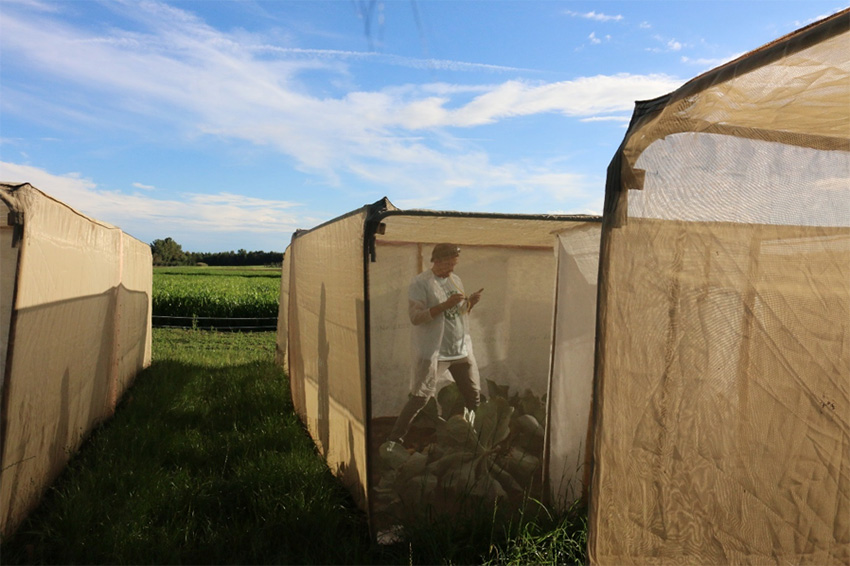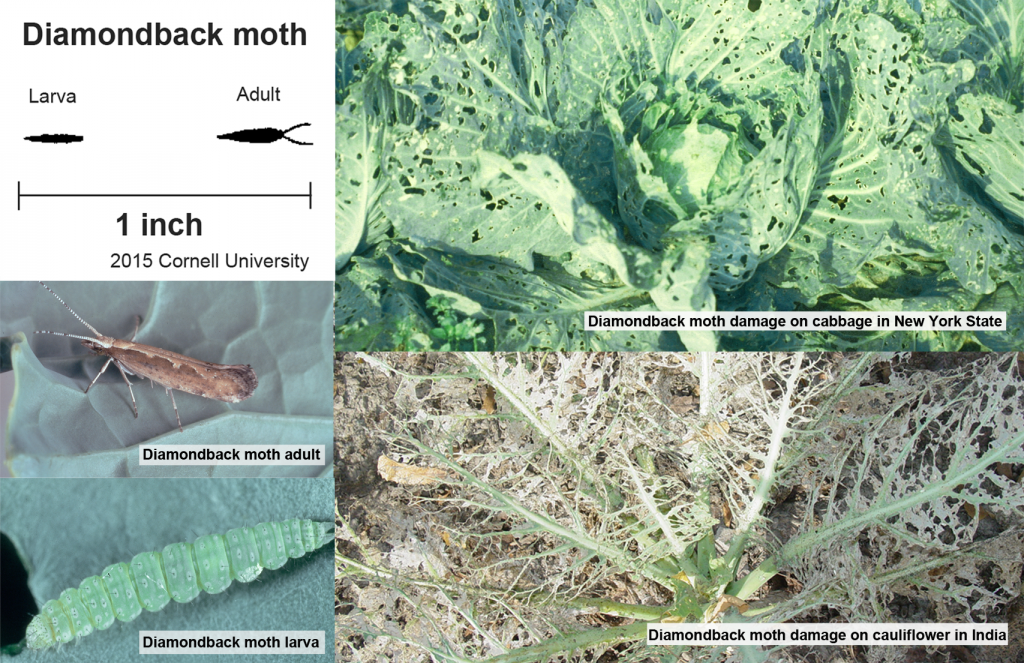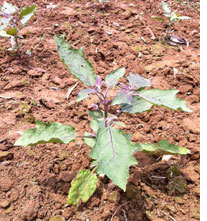Genetically Engineered Diamondback Moth Field Cage Trials
Cornell University, USA, 2015
Trials summary
In previous greenhouse experiments, releases of male self-limiting genetically engineered (GE) diamondback moths suppressed a target pest population and reduced the population’s resistance to an insecticide [1]. In the summer of 2015, we assessed performance of GE male moths under more natural conditions – in large field cages – to evaluate their behavior and potential effectiveness for future diamondback moth pest management strategies.
In 2015, results of field cage experiments indicated that:
- GE and non-GE male moths showed similar longevity.
- GE male moth mating competitiveness was lower than that of non-GE males, but still in an acceptable range and higher than the performance of males in past and current mating-based pest management programs.
- Population modelling indicates that, based on performance levels of GE male moths in these field cage experiments, release of GE males during the early season will result in highly effective suppression of diamondback moth populations.
The field cage results from the experiments described here, together with population modelling, have the ability to enable design of future diamondback moth management strategies and provide evidence to support future trials.
Introduction
Glasshouse cage experiments in the United Kingdom and at Cornell University, in the United States, demonstrated that the GE strain of diamondback moth, called ‘OX4319L’, can suppress a target pest population [1]. In netted field cages, we set out to assess field performance characteristics of GE male moths to investigate their potential effectiveness in future pest management programs, and provide evidence for future biosafety assessments. In August and September 2015, a team led by Professor Anthony Shelton conducted field cage experiments at Cornell University’s New York State Agricultural Experiment Station in Geneva, New York, US.
These experiments measured mating competitiveness and longevity of GE male moths, relative to non-GE counterparts, in field cages.
These experiments were conducted under the conditions stipulated in USDA-APHIS-BRS permit 13-297-102r-a1.
How the field cage experiments were conducted
To test mating competitiveness of the engineered male moths, GE male moths and non-GE male moths, as well as female non-GE moths, were co-released into the field cages. The moths were allowed to mate freely over a period of days. Female moths were collected and, back in the laboratory, their offspring evaluated. We were able to distinguish offspring of GE and non-GE males, and counts of each group provided a measure of mating success of each male type.
Male moths collected from these field cages were used to assess relative survival of GE and non-GE male moths.
Results
We found no significant difference between the GE and the non-GE males in either the recapture rate or their longevity in the field cages. Although mating performance was lower than the non-GE comparative insect, it was still considered in an acceptable range and exceeded the mating success of insects from previous mating-based pest management programs.
These results were incorporated into a population model designed to predict the effect of sustained releases of GE males on the population size of pest diamondback moths. The model indicated that regular releases of these GE males would lead to effective suppression of a target pest population.
Conclusions
In the experiments conducted in field cages, the GE moth showed a strong performance in the first trials under field conditions. The field cage longevity analysis showed that there was no significant difference between the GE and the non-GE comparative in either the recapture rate or the longevity over the time period assessed. The GE males performed well in competing against non-GE males for female mates.

Proposed Diamondback Moth Field Trials, Cornell University
Following the successful field cage trials in 2015, our objective is to study the field behavior of the male GE moths in an experimental crucifer field at Cornell University’s New York State Agricultural Experiment Station in Geneva, New York, US. The GE males showed strong performance in field cages, and studying their dispersal and survival in an open crucifer field, relative to non-GE male moths, will provide further information on the potential of the GE diamondback moth for future integrated pest management strategies on farms.
We will conduct releases of male moths of the Oxitec strain (OX4319L), used in our previous studies, and non-engineered male moths. After each release, we will monitor movement by recapturing each moth type on sticky traps distributed around the release site and outside the trial cabbage field, measuring male moth dispersal and persistence. These types of experiments, termed ‘mark-release-recapture’ trials, are a standard way for scientists to assess how an insect behaves in field conditions. The color marker carried by the GE moths will allow us to distinguish the two moth types, and based on where we recapture them and how long this happens after their release, we can estimate how far they typically travel in a field and how long they survive in the face of natural weather conditions and predators.
We anticipate releasing a few thousand moths per release in the field in these proposed early-stage trials. On a per acre basis in an infested field, this level of insects would not be considered excessive. We expect to release around 50,000 moths during the trials. Depending on the results, multiple trials will be conducted over the course of the project.
In addition to field trials, further caged trials may also take place.
- Harvey-Samuel, T., N. Morrison, A. Walker, T. Marubbi, J. Yao, H. Collins, K. Gorman, T. G. Emyr Davies, N. Alphey, S. Warner, A. M. Shelton, L. Alphey. 2015. Pest control and resistance management through releases of insects carrying a male-selecting transgene. BMC Biology 13:49 doi:10.1186/s12915-015-0161-1


 I found the exact opposite to be true. Mr. Islam and his associate proudly showed me his field of Bt brinjal. It was free of pest damage, and they were very pleased with the crop. Normally, they would have already sprayed insecticides on the plants to control the brinjal fruit and shoot borer, but did not have to since the plants resisted their attack. They were pleased to see no borer injury — as were the rest of us who were there inspecting the crop.
I found the exact opposite to be true. Mr. Islam and his associate proudly showed me his field of Bt brinjal. It was free of pest damage, and they were very pleased with the crop. Normally, they would have already sprayed insecticides on the plants to control the brinjal fruit and shoot borer, but did not have to since the plants resisted their attack. They were pleased to see no borer injury — as were the rest of us who were there inspecting the crop. Bt brinjal also allows farmers to use “integrated pest management,” or IPM, to control minor brinjal pests like aphids, thrips, leafhoppers, and whiteflies. Some of these pests can be controlled by other insects — biological control agents like ladybird beetles and lacewings. These beneficial insects are harmed by conventional and organic insecticide sprays. In using resistant plants instead of pesticides to control the borers, farmers allow beneficial insect populations to flourish.
Bt brinjal also allows farmers to use “integrated pest management,” or IPM, to control minor brinjal pests like aphids, thrips, leafhoppers, and whiteflies. Some of these pests can be controlled by other insects — biological control agents like ladybird beetles and lacewings. These beneficial insects are harmed by conventional and organic insecticide sprays. In using resistant plants instead of pesticides to control the borers, farmers allow beneficial insect populations to flourish.